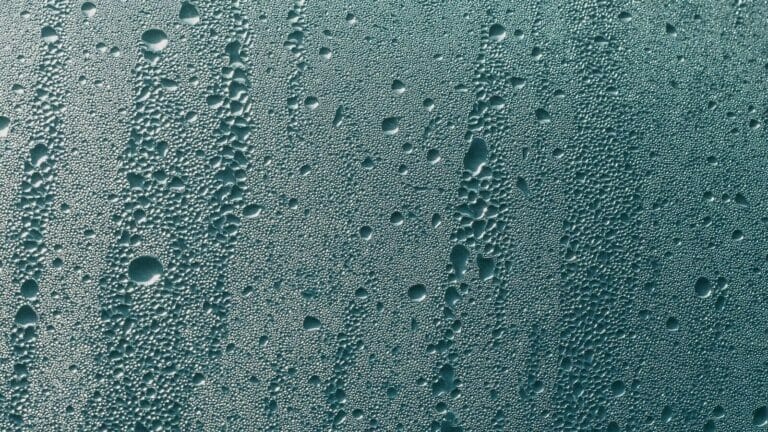Have you been waking up to a blurry view from your window during the cold winter months? Don’t panic! Condensation is perfectly normal and you may not need to take any action. In this post, we unravel the condensation conundrum: what is causing it, whether to be concerned about it and what to do about it.
Quick FAQs
[rank_math_rich_snippet id=”s-566bb2a1-5ffc-4d38-827e-0ade501fa7b9″]
What Is Condensation On Windows and What Causes It?
Condensation – or fogging – on windows is caused by excess moisture (or water vapour) in the air. Many everyday activities in the home cause moisture, such as running baths and showering, washing and drying clothes, and cooking and boiling the kettle.
As the moisture-packed air collides with cold surfaces (such as a pane of glass), it quickly cools down and turns into liquid droplets on the cold surface. The more moisture in the air, the higher the temperature in your home and the lower the surface temperature of the windows, the more condensation will occur.
Why Is There Condensation On the Outside of My Window?
If the condensation is on the outside of your windows, it’s good news! It’s actually a sign that your windows are doing their job well, preventing heat loss from your home and preventing the cold air from entering.
Why Is There Condensation On the Inside of My Window?
Condensation on the inside of the windows often occurs in the colder months when the warm air inside the houses hits the cold panes of glass and turns it into water droplets. Again, the condensation itself isn’t anything to worry about – in fact, it means your windows are preventing heat loss from your home – but it’s important not to let the moisture inside start to pool.
Why Is There Condensation Between My Window Panes?
Condensation between the panes of glass in double-glazed windows is a problem that needs addressing. If there’s moisture between the panes of glass, it means that the seals are no longer doing their job properly. Broken seals mean your property is losing heat, which means you’ll be spending more on energy to keep your home warm; that’s not great with energy costs rising so steeply! The only way to deal with broken seals is to replace your windows.
What Should I Do about the Condensation On My Windows?
If the condensation is between the panes of glass in your double-glazed windows, it’s time to speak to a professional about replacing your windows.
If the condensation is on the outside of your windows, you probably don’t need to take any action. It would be wise, however, to check that the sills and frames have no gaps that could allow moisture to collect inside the walls.
If the condensation is on the inside of your windows, remove it first thing every morning, as this is when it’s at its worst. Wipe the windows with a clean microfibre cloth or use an absorbent paper towel, then use a fresh towel or a squeegee to dry the pane afterwards to prevent mould from forming. If mould has already formed, you can use a steam cleaner, which should remove and kill the spores.
Check for any damage if condensation is persistently a serious problem and get an expert’s opinion as to whether your windows need upgrading.
How to Prevent Condensation On Windows
There are a number of suggestions for preventing or reducing condensation on windows:
- Ventilation to reduce condensation – Over the last thirty years or so, homes have become much more energy-efficient. The downside of preventing heat loss through well-fitting windows and doors is that there is no longer any natural ventilation.
- Open blinds or curtains to let moisture escape – Condensation can form if moisture is trapped between the blinds or curtains and the window. Open up blinds and curtains during the daytime to let the air circulate and any moisture escape.
- Using a dehumidifier to stop condensation – Automatic dehumidifiers can be expensive but may be worth the investment if condensation is a big problem in your home. More affordable dehumidifier boxes with damp crystals work by removing excess moisture from the air.
- Using extractor fans to help with condensation – Bathrooms and kitchens benefit enormously from sufficient extraction. They reduce humidity in bathrooms and shower rooms, and remove smoke, smells and moisture from the air in kitchens.
- Change the way you heat your home to address condensation – Setting your thermostat a little lower – just a couple of degrees – will mean the difference between the temperature outdoors and indoors is less extreme.
- How trickle vents prevent condensation – The purpose of trickle vents is to allow for air circulation without having to open the windows. If your windows have trickle vents, make sure you use them – especially in rooms where humidity and moisture are more likely to be a problem, such as bathrooms and kitchens. If you’re considering replacing your windows, consider trickle vents ‘a must’.
Condensation in Conclusion
Depending on where it is, how often it’s occurring and how much moisture there is, condensation on your windows may not be anything to worry about. Stay on top of condensation on the inside of your windows by wiping it off and drying it. Try the other tips mentioned in this post, particularly using trickle vents or slightly opening windows to let air circulate in your home. As the weather warms up, condensation won’t be something you’ll need to think about for a while and you’ll be able to enjoy those clear views from your window in the mornings once again.
Need to discuss new windows or doors?
If you think your windows or doors are the root cause of condensation, consider speaking to our glazing experts for advice.

